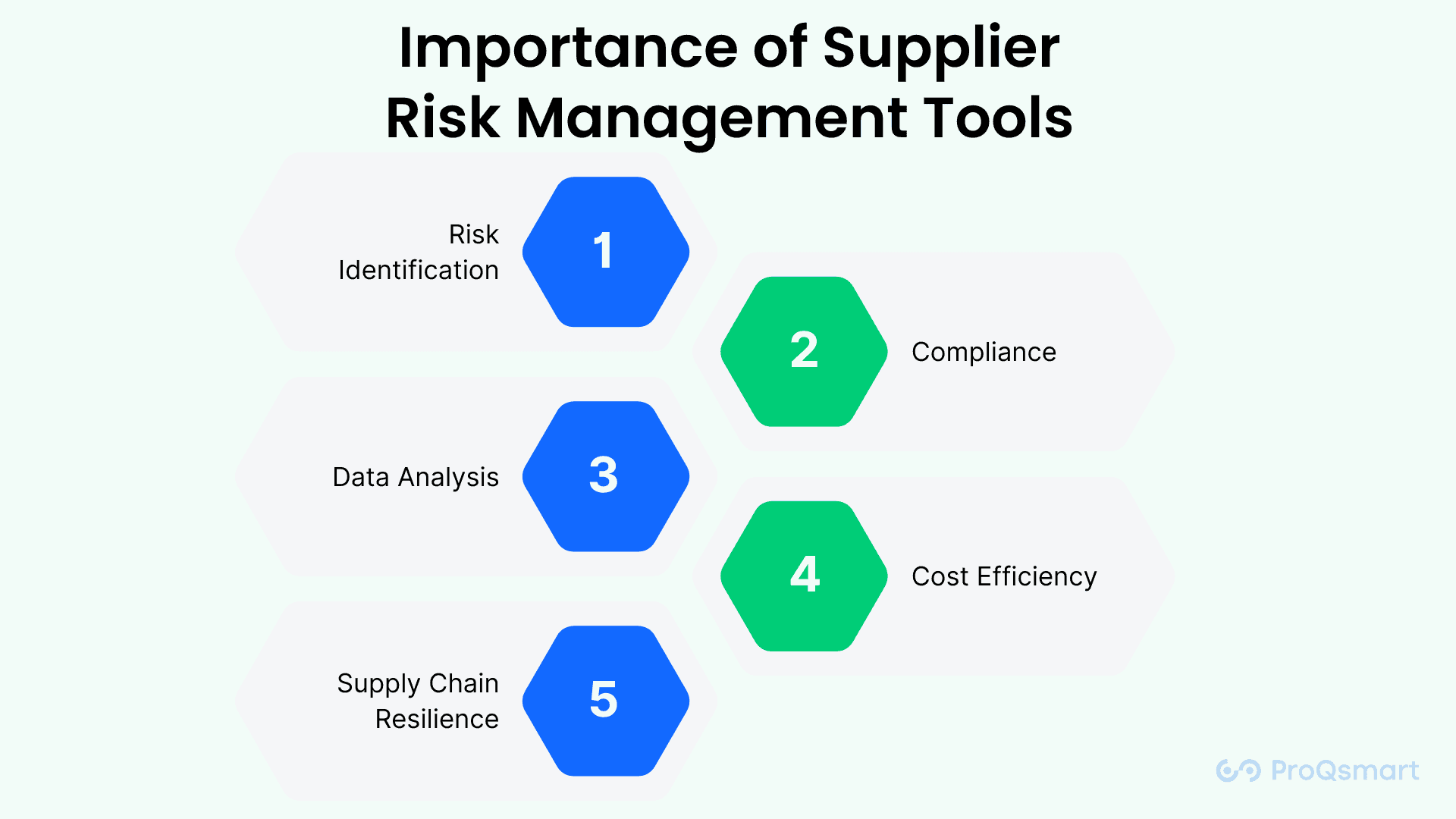In today’s globalized business environment, managing supplier risk is crucial for maintaining a robust and resilient supply chain. Supplier risk management tools are essential for identifying, assessing, and mitigating risks associated with supplier relationships. These tools help businesses ensure compliance, enhance supply chain visibility, and safeguard operations from disruptions. This comprehensive guide will explore the best management tools, their key features, benefits, and best practices for effective supplier risk management.
What are Supplier Risk Management Tools?
Supplier risk management tools are software solutions designed to help businesses monitor, evaluate, and mitigate risks associated with their suppliers. These tools provide real-time insights, automate risk assessment processes, and facilitate compliance management. By leveraging management tools, companies can proactively address potential issues, ensure business continuity, and optimize their supply chain operations.
Importance of Supplier Risk Management Tools

- Risk Identification: Detect potential risks early in the supplier relationship.
- Compliance: Ensure suppliers meet regulatory and corporate compliance requirements.
- Data Analysis: Analyze supplier performance and risk data for informed decision-making.
- Cost Efficiency: Reduce costs associated with supplier disruptions and compliance failures.
- Supply Chain Resilience: Enhance the overall resilience and reliability of the supply chain.
Key Features of Supplier Risk Management Tools
Supplier risk management tools come with a variety of features designed to enhance risk assessment and mitigation processes. Here are some key features to look for:
1. Risk Assessment and Scoring
These tools provide risk assessment and scoring capabilities to evaluate suppliers based on various risk factors such as financial stability, operational efficiency, compliance history, and geopolitical risks. Risk scoring helps prioritize suppliers based on their risk levels.
2. Real-Time Monitoring
Real-time monitoring features allow businesses to continuously track supplier performance and risk indicators. This includes monitoring financial health, production capacity, delivery performance, and compliance status.
3. Compliance Management
Compliance management tools ensure that suppliers adhere to industry standards, regulatory requirements, and corporate policies. These tools facilitate document collection, verification, and tracking of certifications and compliance reports.
4. Supplier Risk Database
A centralized supplier risk database stores all relevant information about suppliers, including risk assessments, performance metrics, compliance records, and communication logs. This database provides a comprehensive view of each supplier’s risk profile.
5. Data Integration
Data integration capabilities enable the tool to connect with other systems such as ERP, procurement, and supply chain management software. This ensures seamless data flow and enhances overall supply chain visibility.
6. Analytics and Reporting
Advanced analytics and reporting features provide insights into supplier performance, risk trends, and potential vulnerabilities. These tools generate detailed reports and dashboards to support data-driven decision-making.
7. Risk Mitigation Plans
Supplier risk management tools help develop and implement risk mitigation plans. This includes creating contingency plans, defining risk response strategies, and setting up automated alerts for risk events.
8. Collaboration and Communication
Collaboration tools facilitate communication between internal teams and suppliers. This includes secure messaging, document sharing, and issue resolution platforms to enhance transparency and collaboration.
Benefits of Using Supplier Risk Management Tools
Implementing supplier risk management tools offers numerous benefits that contribute to the efficiency and effectiveness of supply chain operations. Here are some key benefits:
1. Enhanced Risk Visibility
These tools provide comprehensive visibility into supplier risks, enabling businesses to identify and address potential issues before they escalate. Real-time monitoring ensures that risks are detected early and managed proactively.
2. Improved Compliance
Management tools ensure that suppliers comply with regulatory requirements and corporate policies. This reduces the risk of non-compliance and associated legal and financial penalties.
3. Data-Driven Decision Making
By providing detailed insights and analytics, these tools support data-driven decision-making. Businesses can make informed choices about supplier selection, risk mitigation strategies, and overall supply chain management.
4. Cost Reduction
Effective supplier risk management reduces costs associated with supplier disruptions, compliance failures, and operational inefficiencies. Proactive risk management helps avoid costly disruptions and enhances supply chain efficiency.
5. Strengthened Supplier Relationships
These tools foster better communication and collaboration with suppliers, leading to stronger relationships. By working closely with suppliers to manage risks, businesses can build trust and enhance supplier performance.
6. Increased Supply Chain Resilience
Management tools enhance the resilience of the supply chain by identifying vulnerabilities and implementing mitigation strategies. This ensures that the supply chain can withstand disruptions and continue to operate smoothly.
Top Supplier Risk Management Tools
There are several supplier risk management tools available in the market, each offering unique features and capabilities. Here are some of the top tools to consider:
1. SAP Ariba Supplier Risk
SAP Ariba Supplier Risk provides comprehensive risk assessment and management capabilities. It offers real-time monitoring, risk scoring, compliance management, and integration with other SAP Ariba solutions. The tool helps businesses proactively manage supplier risks and enhance supply chain resilience.
2. RiskMethods
RiskMethods offers a powerful management platform that provides real-time risk monitoring, risk scoring, and automated alerts. The tool integrates with other systems to provide a holistic view of supplier risks and supports data-driven decision-making.
3. Resilinc
Resilinc specializes in supply chain risk management, offering tools for supplier risk assessment, real-time monitoring, and risk mitigation planning. The platform provides detailed analytics and insights to help businesses manage risks effectively and enhance supply chain resilience.
4. Achilles
Achilles provides a comprehensive solution that includes risk assessment, compliance management, and performance monitoring. The tool helps businesses identify and mitigate risks, ensure compliance, and build stronger supplier relationships.
5. LexisNexis Entity Insight
LexisNexis Entity Insight offers a robust management tool that provides real-time risk monitoring, risk scoring, and compliance management. The tool leverages advanced analytics and data integration capabilities to provide comprehensive risk insights.
6. Avetta
Avetta focuses on supplier compliance and risk management, offering tools for risk assessment, compliance verification, and performance monitoring. The platform helps businesses ensure that suppliers meet regulatory requirements and corporate standards.
7. Coupa Risk Aware
Coupa Risk Aware is part of the Coupa Business Spend Management platform and provides supplier risk assessment, real-time monitoring, and compliance management. The tool integrates with other Coupa solutions to enhance overall supply chain visibility and control.
Best Practices for Effective Supplier Risk Management
To maximize the benefits of management tools, it is essential to follow best practices. Here are some key best practices for effective supplier risk management:
1. Define Clear Risk Management Objectives
Clearly define your risk management objectives and align them with your overall business goals. Identify the specific risks you want to manage and the outcomes you aim to achieve.
2. Develop a Comprehensive Risk Management Plan
Create a comprehensive risk management plan that outlines your risk assessment, mitigation, and monitoring strategies. Include roles and responsibilities, processes, and tools required to manage supplier risks effectively.
3. Involve Key Stakeholders
Involve key stakeholders from various departments, including procurement, compliance, finance, and operations, in the risk management process. This ensures that all perspectives are considered and that risk management efforts are aligned across the organization.
4. Leverage Advanced Analytics
Use advanced analytics and reporting tools to gain deeper insights into supplier risks. Analyze risk data to identify trends, predict potential issues, and make informed decisions.
5. Foster Collaboration with Suppliers
Promote open communication and collaboration with suppliers to address risks proactively. Work closely with suppliers to develop risk mitigation plans and improve overall performance.
6. Monitor Risks Continuously
Continuously monitor supplier risks using real-time monitoring tools. Regularly update risk assessments and adjust mitigation strategies based on new information and changing conditions.
7. Conduct Regular Audits
Perform regular audits of supplier risk management processes to ensure compliance with policies and identify areas for improvement. Audits help maintain the effectiveness of risk management efforts.
8. Provide Training and Support
Provide training and support to your team on using management tools and implementing best practices. Ensure that everyone involved understands their roles and responsibilities in managing supplier risks.
Conclusion
Supplier risk management tools are essential for maintaining a robust and resilient supply chain. By leveraging these tools and following best practices, businesses can proactively manage supplier risks, ensure compliance, and enhance overall supply chain performance. Implementing the right management tool can lead to significant improvements in efficiency, cost savings, and supply chain resilience.


